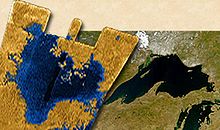
Back Колонизация на Титан Bulgarian Colonització de Tità Catalan Colonización de Titán Spanish Titanin asuttaminen Finnish Colonisation de Titan French Kolonisasi Titan ID Colonizzazione di Titano Italian Możliwości eksploatacji Tytana Polish Colonização de Titã Portuguese Colonizarea lui Titan Romanian

Saturn's largest moon Titan is one of several candidates for possible future colonization of the outer Solar System, though protection against extreme cold is a major consideration.
According to Cassini data from 2008, Titan has hundreds of times more liquid hydrocarbons than all the known oil and natural gas reserves on Earth. These hydrocarbons rain from the sky and collect in vast deposits that form lakes and dunes.[1] "Titan is just covered in carbon-bearing material—it's a Mega factory of organic chemicals", said Ralph Lorenz, who leads the study of Titan based on radar data from Cassini. "This vast carbon inventory is an important look into the geology and climate history of Titan." Several hundred lakes and seas have been observed, with several dozen estimated to contain more hydrocarbon liquid than Earth's oil and gas reserves. The dark dunes that run along the equator contain a volume of organics several hundred times larger than Earth's coal reserves.[2]

Radar images obtained on July 21, 2006, appear to show lakes of liquid hydrocarbon (such as methane and ethane) in Titan's northern latitudes. This is the first discovery of currently existing lakes beyond Earth.[3] The lakes range in size from about a kilometer in width to one hundred kilometers across.
On March 13, 2007, the Jet Propulsion Laboratory announced that it found strong evidence of seas of methane and ethane in the northern hemisphere. At least one of these is larger than any of the Great Lakes in North America.[4][clarification needed]
- ^ Findings from the study led by Ralph Lorenz, Cassini radar team member from the Johns Hopkins University Applied Physics Laboratory, USA, are reported in the 29 January 2008 issue of the Geophysical Research Letters.
- ^ "Titan's surface organics surpass oil reserves on Earth". European Space Agency. February 13, 2008. Retrieved October 20, 2016.
- ^ "PIA08630: Lakes on Titan". Photojournal. NASA/JPL. July 24, 2006. Retrieved October 28, 2014.
- ^ "Cassini Spacecraft Images Seas on Saturn's Moon Titan". Cassini Solstice Mission. NASA/JPL. March 13, 2007. Archived from the original on October 28, 2014. Retrieved October 28, 2014.
© MMXXIII Rich X Search. We shall prevail. All rights reserved. Rich X Search